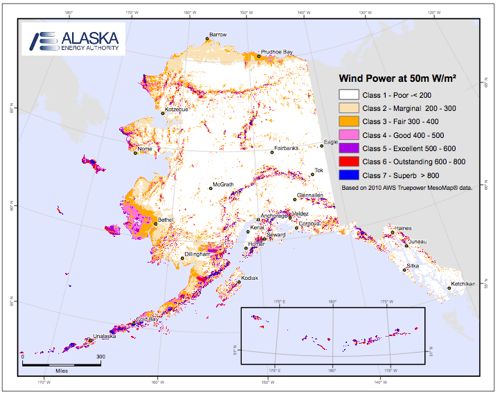
Southeast Alaska is generally considered a poor wind prospect, but Sitka’s utility director Chris Brewton says wind turbines could work as “trickle chargers” to help keep more water in the hydroelectric reservoirs.
In the middle of building the most expensive hydro project in the community’s history, the assembly took a few minutes at its last meeting (10-7-13) to look at some comparatively inexpensive energy.
It gave the Electric Department the go-ahead to work with the Alaska Energy Authority on a wind power test.
Wind power has been discussed before in Sitka — and dismissed — since the area’s hydro prospects are so good.
But utility director Chris Brewton says we’ve been looking at wind power the wrong way. Sitka is never going to run on wind, but that doesn’t mean wind can’t be useful.
“It would essentially act as a trickle charger to keep the water in the lake, is what would happen.”
Brewton asked the assembly for permission to coordinate with the Alaska Energy Authority to install three 10-meter towers, and one 30-meter tower, to gather data on Sitka’s wind. The test towers are a far cry from the huge, utility-grade turbines being installed in California and other parts of the lower forty-eight. They look more like antennas: tall poles with anemometers mounted at various heights.
“If it does turn out we find a good site and install a turbine, there will be aesthetic impacts, and other kinds of things that we have to accept to put up the wind tower.”
Learn more about the AEA Wind Energy program.
Brewton says the AEA begins with a public meeting. Hearing concerns about aesthetics is important. So is hearing about where it’s windy.
“A lot of folks are familiar with some of these canyons, where the wind whistles through nonstop. So that would be one of the key things we’d look for in public input.”
The test towers would be paid for by the AEA. All Sitka’s utility would pay for is installation, and data collection, which lasts anywhere from 1 to 2 years. The towers should be installed close to Sitka’s existing generation system. Brewton thinks somewhere back along the ridges behind Green Lake might work out.
The AEA has produced a wind map. Southeast is generally considered a poor prospect for wind power. When he worked in Ketchikan, Brewton asked — and was turned down — for a similar test.
This time, the AEA came to him.
“There’s been some good experiments and some good situations. The Kodiak wind integration has been very successful out there. They have three turbines, and now they’re going to six. And they’re significantly reducing their diesel generation. In their case it’s really been a positive thing. And if you’ve been to Kodiak recently you’ll see the turbines on top of Pillar Mt. right downtown.”
Assembly member Matt Hunter teaches math and science at Mt. Edgecumbe High School. He spearheaded a wind turbine project there, which still operates next to the Maple dock.
Hunter was eager to have Sitka work with the AEA.
“A couple of years ago we put a wind turbine up at Mt. Edgecumbe campus. A 60-foot tower. I’ve walked around it almost daily during the school year, or biked by it, at least. I haven’t found any bird kill, which is fantastic for two years. It’s produced just over 2,000 kilowatt hours, which is just over 2 megawatt hours, which is about 10-minutes of a 15 megawatt electrical load, which is what Sitka routinely pulls. So that little turbine in its two years has powered Sitka for about 10 minutes. Kinda cool.”
The assembly voted 4-0 to have the administration draft a memorandum of agreement with the Alaska Energy Authority.
Members Esquiro, Reif, and Hackett were absent.































